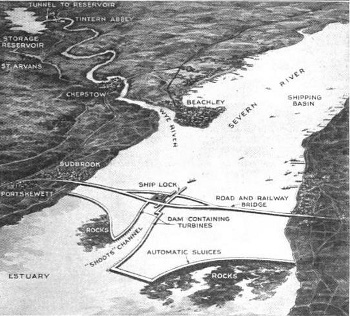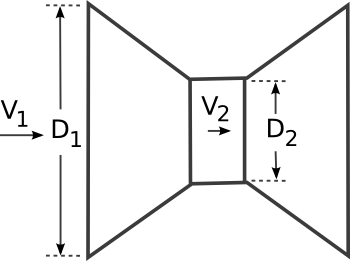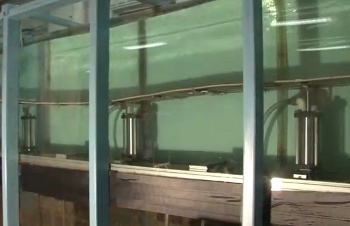Tidal and Wave Energy
March 24, 2014
When we think about
renewable energy sources,
solar energy is the first thing that springs to mind. The average
insolation arriving at the top of
Earth's atmosphere from the
Sun is about
1360 watts per square meter. At ground level, however, we have a daily average insolation of just 250
watts per
square meter.
The deficit is a consequence of
atmospheric absorption, the absence of
sunlight at
night, and the fact that the Sun is usually not overhead, so its rays
project on Earth's surface at an angle. When we factor in the less than 25%
efficiency of today's
photovoltaics, we have a solar energy collection ability of just slightly more than fifty watts per meter, averaged over a year. Then there's the problem of
storing the energy during the day for use at night.
There's another form of renewable energy, and that's lunar energy, better known as
tidal power. You can extract tidal power at all times of day, since the
tides are always
ebbing or flooding, although there is variability from high
vs low tides.

Time and tide wait for no man.
Cnut the Great of the North Sea Empire is famous for setting his throne at the water's edge and commanding the tide to stop.
(From the Genealogical roll of the kings of England (c. 1300 - c. 1340), Royal MS 14 B VI of the British Library, via Wikimedia Commons.)
One method of extracting energy from the tides is a variation of
hydroelectric power known as a
tidal barrage. As in a conventional
hydroelectric power plant, a
dam is involved, which isolates a
bay or other
estuary from the sea tides. Water will move through
turbine generators into the bay or estuary at high tide, and it will move in the opposite direction at low tide.
A tidal barrage can generate power equivalent to a small
nuclear power plant, with no
high technology required. As shown in the figure, a massive tidal barrage was proposed as early as 1921 at the
Severn Estuary at the border between
England and
Wales.

Diagram of a 1921 plan for a tidal barrage at the Severn Estuary in the United Kingdom at the border between England and Wales.
(Illustration from a 1921 issue of Popular Mechanics, via Wikimedia Commons.)
Tidal stream generators are essentially
wind turbines placed underwater, although there are architectural variations on this theme that are difficult to do on land. Under the sea, you can
duct the tidal flow to produce a higher
velocity stream at your
water turbine. These water versions of wind turbines can be much smaller, since the working
fluid is the much
denser water, which packs a lot of
momentum into its flow.

Why a duct?
If we consider water to be an incompressible fluid, conservation of momentum in a circular duct requires that
V2 = V1(D1/D2)2
(Illustration by the author using Inkscape.)
Tidal power is not the only way that energy can be extracted from the
oceans. You can extract solar energy as well as lunar energy from the oceans through
ocean waves. Ocean waves are driven by the
wind, which, in turn, is driven by the Sun. Wind excites waves over large
areas of the ocean, and these can travel great distances before reaching a
shore. This means that waves will still appear in your locale even when it's not locally windy.
Even waves of a modest height are still raising large
volumes of water against the
force of gravity, so
they contain considerable energy. A novel method of energy extraction from ocean waves is being explored by a team of
mechanical engineers led by
professor M. Reza Alam of the
Mechanical Engineering Department of the
University of California, Berkeley. The device is an
elastomer carpet coupled to
hydraulic cylinders.[1-2] Says Alam,
"There is a vast amount of untapped energy in the oceans, and with increasing worldwide demand for power, the need to find cleaner alternatives to fossil fuels is critical... We are also seeing greater population growth along coastal cities, so the ocean-based system we are developing would produce electricity in a carbon-neutral way right where it is needed."[1]
The device, as shown in the photograph, is a sheet of
rubber mounted on a grid of hydraulic cylinders. The rubber sheet moves up and down with the waves, pumping the cylinders, which transmit
hydraulic pressure back to shore for conversion into electricity. The rubber elastomer, of course, is the weak point of the system, since it needs to
repeatedly flex, and it's located in a
corrosive environment. Best placement of the carpet would be at a sixty foot depth in shallow coastal waters.[1]

Wave energy converter in a wave tank.
An online video shows how the motion of the carpet tracks the wave motion.[2]
(Still image from a YouTube video.[2]
Studies have shown that wave power worldwide has the potential to provide more than 2,000
terawatt hours of electricity per year. This is about 10 percent of global electrical needs.[1] The Berkeley
experiments have shown that their system could extract more than 90% of incoming wave energy, and that just a square meter of the carpet could generate the electrical requirements for two US
households. A hundred square meters of carpet placed at the
California coastline can generate as much power as 6,400 square meters of photovoltaics.[1]
The Berkeley team most recently presented results of their experiments at the 10th
10th European Wave and Tidal Energy Conference,
Aalborg University,
Denmark, September, 2013.
References:
- Sarah Yang, "Seafloor carpet catches waves to generate energy," University of California, Berkeley, Press Release, January 28, 2014.
- Berkeley Team Producing Energy from Ocean Waves, YouTube video produced by Roxanne Makasdjian and Phil Ebiner, January 28, 2014.
Permanent Link to this article
Linked Keywords: Renewable energy sources; solar energy; insolation; atmosphere of Earth; Earth's atmosphere; Sun; solar constant; watts per square mete; atmospheric absorption; sunlight; night; projection effect; energy conversion efficiency; photovoltaics; energy storage; tidal power; tide; ebbing; flooding; Time and tide wait for no man; Cnut the Great; North Sea Empire; throne; Ruler of the waves; commanding the tide to stop; British Library; Wikimedia Commons; hydroelectric power; tidal barrage; hydroelectricity; hydroelectric power plant; dam; bay; estuary; electric generator; turbine generator; nuclear power plant; high technology; Severn Estuary; England; Wales; United Kingdom; Popular Mechanics; tidal stream generator; wind turbine; duct; velocity; water turbine; fluid; density; water; momentum; Why a Duck?; compressibility; incompressible; conservation of momentum; circle; circular; Inkscape; ocean; ocean wave; wind; area; shore; volume; gravitation; force of gravity; mechanical engineering; mechanical engineer; professor; M. Reza Alam; Mechanical Engineering Department; University of California, Berkeley; elastomer; carpet; hydraulic cylinder; fossil fuel; population growth; city; electricity; carbon neutrality; carbon-neutral; synthetic rubber; hydraulics; hydraulic pressure; fatigue; corrosion; corrosive; YouTube video; terawatt hour; experiment; household; California; 10th European Wave and Tidal Energy Conference; Aalborg University; Denmark.